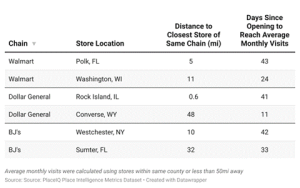Ramp-up visit rates for Big Box and Dollar Stores can be over twice as fast for locations that have opened in new markets versus ones in existing markets.
For Precisely PlaceIQ, it is common for to utilize the data to assist clients with new store openings. Our methodology includes measuring a new store’s opening performance by answering questions such as: “What is the rate of visitation since opening?,” “How have visitation trends changed over time,?” and “What is the share of visits compared to nearby stores?.” After our clients analyze a store’s initial performance, our data and dashboards enable them to help ensure continued success with our audiences to target relevant individuals in the surrounding area. Using Place Intelligence Metrics, we begin the first step of this process by analyzing the opening performance of six stores in the Big Box and Dollar Store categories.
The first 30 days after opening a store are critical to its success. During this time, the store is working to attract new customers and establish a loyal following. Several factors can influence the success of a store’s opening, such as its location in or near high-traffic areas, promotions or competitive pricing, a wide selection of products, or targeted advertising. In addition to these factors, we found that the speed to find a market is also directly correlated to the distance from existing same brand locations.
Read our Audience Handbook
Precisely PlaceIQ Syndicated Audience Handbook
Read this handbook and explore real-world audiences to discover new and innovative ways to reach high-value consumers.
For instance, a new Walmart can ramp up twice as fast in new markets as they can in existing markets. Dollar stores, on the other hand, may see a difference of up to 4x in ramp-up rates between new and existing markets. Considering the commonality of seeing multiple dollar stores within 10 miles of one another, the larger jump may be due to factors like a loyal customer base where customers are more likely to choose the store that is most convenient for them. Warehouse Clubs like BJ’s may see similar ramp up rates no matter the market since shopping there requires a membership, and people tend to stock up less frequently than Walmart or Dollar General.
Opening a new store is a significant investment, but with careful planning and attention to key factors, retailers can increase their chances of success in the first 30 days. Location research should be carefully considered when opening a new store since newer markets offer larger boosts in traffic rates.
Place Intelligence Metric (PIM) is a location-based dataset that contains metrics about visitors to a place on a weekly basis. It can be used to analyze a range of visitation behaviors, including trends, seasonality, and visitor attributes. For the purposes of our analysis, we used visitation trends from this dataset between 2021 and 2022.
Table for chain, store, distance to nearest store of same chain, days to reach the average monthly visits

Standardized cumulative visits for Walmart, Dollar General, and Bj’s stores
When opening a new store, it’s important to have different expectations depending on whether the store is in isolation or in an existing market. For stores not near their current footprint, retailers can expect a faster return on investment as the novelty of a new chain may attract first-time customers. However, for stores that are opening in existing markets, marketers need to run more aggressive promotions and advertising. By doing so, retailers can attract customers who are already familiar with their brand and build a loyal customer base in the area.
To learn more, read our Precisely PlaceIQ Syndicated Audience Handbook and explore real-world audiences to discover new and innovative ways to reach high-value consumers.







